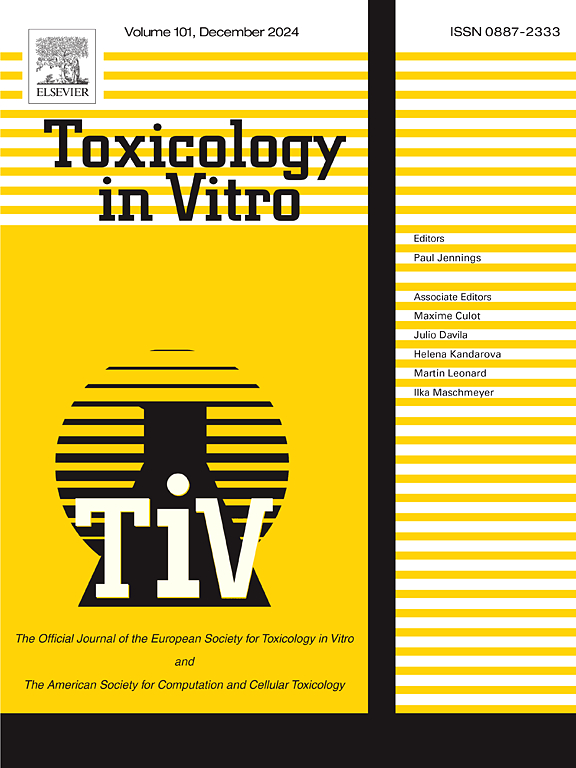Antibiotics reduce intestinal bile acid reuptake in an in vitro model system
IF 2.6
3区 医学
Q3 TOXICOLOGY
引用次数: 0
Abstract
Enterohepatic circulation of bile acids is a highly efficient process that is important for bile acid homeostasis. The aim of the present study was to characterize the impact of a series of antibiotics (lincomycin, streptomycin, vancomycin and tobramycin) on the intestinal reuptake of conjugated bile acids (TCA, TCDCA, GCA and GCDCA) using a Caco-2 in vitro transwell model system. The results obtained demonstrate that both pre-exposure and co-exposure of the cells to an antibiotic and the bile acids, affected bile acid transport, to an extent that depended on the antibiotic, its concentration and the type of conjugated bile acid tested. Tobramycin, at concentrations in line with dose levels at which this antibiotic induced effects on bile acid homeostasis in vivo, appeared able to inhibit bile acid transport after pre-exposure of the cells, likely resulting from an effect on the expression of bile acid transporters via its effects on protein synthesis at ribosome level. Upon co-exposure of the Caco-2 cells to an antibiotic and the bile acids, all four antibiotics appeared to significantly reduce the transport of especially the conjugated bile acids TCDCA and GCDCA with a potency that decreased in the order vancomycin > tobramycin = streptomycin > lincomycin. The effects observed illustrate the possibility of using a new approach methodology (NAM) to study effects on intestinal bile acid reuptake.
抗生素在体外模型系统中减少肠道胆汁酸再摄取
胆汁酸的肠肝循环是一个高效的过程,对维持胆汁酸的稳态至关重要。本研究的目的是利用Caco-2体外transwell模型系统表征一系列抗生素(林可霉素、链霉素、万古霉素和妥布霉素)对共轭胆汁酸(TCA、TCDCA、GCA和GCDCA)肠道再摄取的影响。结果表明,细胞暴露于抗生素和胆汁酸前和共暴露都会影响胆汁酸的运输,其影响程度取决于抗生素、抗生素浓度和所测试的共轭胆汁酸类型。妥布霉素的浓度与抗生素在体内诱导胆汁酸稳态的剂量水平一致,似乎能够在细胞预暴露后抑制胆汁酸运输,这可能是由于其通过影响核糖体水平的蛋白质合成而影响胆汁酸转运蛋白的表达。当Caco-2细胞同时暴露于一种抗生素和胆汁酸时,所有四种抗生素似乎都显著减少了胆汁酸的运输,尤其是共轭胆汁酸TCDCA和GCDCA,其效力按万古霉素和GCDCA的顺序递减。妥布霉素=链霉素;洁霉素。观察到的效果说明了使用新方法(NAM)研究肠道胆汁酸再摄取影响的可能性。
本文章由计算机程序翻译,如有差异,请以英文原文为准。
求助全文
约1分钟内获得全文
求助全文
来源期刊

Toxicology in Vitro
医学-毒理学
CiteScore
6.50
自引率
3.10%
发文量
181
审稿时长
65 days
期刊介绍:
Toxicology in Vitro publishes original research papers and reviews on the application and use of in vitro systems for assessing or predicting the toxic effects of chemicals and elucidating their mechanisms of action. These in vitro techniques include utilizing cell or tissue cultures, isolated cells, tissue slices, subcellular fractions, transgenic cell cultures, and cells from transgenic organisms, as well as in silico modelling. The Journal will focus on investigations that involve the development and validation of new in vitro methods, e.g. for prediction of toxic effects based on traditional and in silico modelling; on the use of methods in high-throughput toxicology and pharmacology; elucidation of mechanisms of toxic action; the application of genomics, transcriptomics and proteomics in toxicology, as well as on comparative studies that characterise the relationship between in vitro and in vivo findings. The Journal strongly encourages the submission of manuscripts that focus on the development of in vitro methods, their practical applications and regulatory use (e.g. in the areas of food components cosmetics, pharmaceuticals, pesticides, and industrial chemicals). Toxicology in Vitro discourages papers that record reporting on toxicological effects from materials, such as plant extracts or herbal medicines, that have not been chemically characterized.
 求助内容:
求助内容: 应助结果提醒方式:
应助结果提醒方式:


